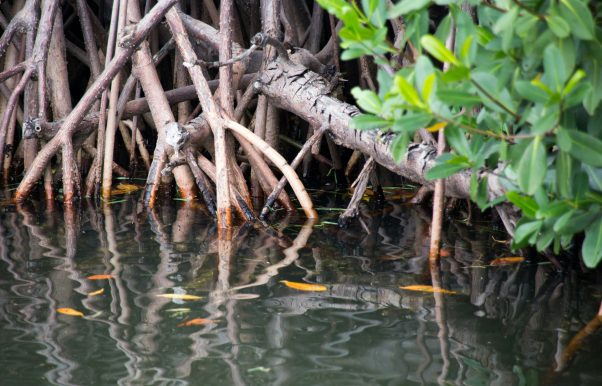Improved Forest Management & the Sustainable Development Goals
Climate change is increasingly putting our forests in danger as the number of wildfires have nearly doubled since the year 2000. In fact, globally, the UN Environment Programme projects that the increase of extreme wildfires will go up by 14% in 2030, 30% by 2050 and 50% by 2100. With this in mind, carbon projects like Improved Forest Management (IFM) projects, are key to improving our forest resiliency to the impacts of climate change.
In this article, we will discuss different IFM sustainable forestry practices, the fire management role of controlled burning in maintaining healthy forests and preventing wildfires, the threat of invasive species, and the relationship between a healthy forest and water resources.
Check out our forestry and land use page for more information.
Benefits to Water Resources
IFM activities that shift from production to conservation can have a strong impact on the Sustainable Development Goal (SDG) 6, Clean Water and Sanitation, as conservation protects and helps improve the forest-water ecosystem. Conserving this water-related ecosystem helps to strengthen both the water quality and the soil’s water retention capacity, positively affecting the forest’s water balance. Another activity, reduced impact logging, reduces the impact on the forest’s soil as there is less disturbance. This activity therefore further enhances the soil’s water retention and filtration abilities, which helps reduce flood risks. Avoiding degradation is an IFM activity that helps to either avoid harvesting that would have occurred in the baseline scenario, or avoid the increase of bad harvesting practices. Therefore, while harvesting of some kind would continue in this project activity, the forest and its water ecosystem is better preserved due to this reduced degradation as the harvest targets higher quality timber.
When a forest is managed correctly, the trees can hold more moisture and have better resistance to insect damage and diseases. When trees cannot hold enough moisture, they are likely to dry out and die, making them the perfect fuel for wildfires. While the forest’s soils are like sponges, absorbing water when there is an abundance and releasing water when it proves scarce, trees are like straws, sucking up water from the soil and transpiring it into the atmosphere to produce the rainfall the forests need. If trees store good amounts of moisture, they can help to stop or slow down wildfires.

Benefits to Life on Land and Biodiversity Conservation
IFM activities that shift from production to conservation can have a strong impact on SDG 15, Life on Land, as conservation at its core aims to further protect the forest through forest stewardship practices to keep it as it is and avoid forest loss. The activity of reduced impact logging helps to avoid the negative effects of conventional tree harvesting, which further contributes towards a forest with more biodiversity and a richness of species.
Another biodiversity conservation strategy that some IFM projects use is introducing controlled burning. Many Indigenous communities managed their land with fire, but through colonization and the introduction of fire suppression policies, these important cultural and forest stewardship practices are being lost. By prescribing low to moderate intensive fires, the forest’s health and wildfire protection increases.
As ecologists and foresters dive deeper into the research of the role of fire management in maintaining a healthy forest ecosystem, we have a better understanding of several benefits of low-moderate intensive fires in maintaining forest health.
Improving the habitat preservation of native wildlife: Low to moderate intensity fires help open the forest canopy and create room for new vegetation to grow. It also helps to create “dead tree zone” structures where birds and bats can claim shelter. As mentioned above, reduced impact logging improves the forest’s soil quality, and by reducing the amount of trees lost due to conventional harvesting, this activity further contributes to a positive species diversity and richness.
Increasing the forest’s biodiversity: Non-native species that cause harm to the area are called invasive species. These invasive species are hard to control as there is a lack of natural predators and protections. Invasive species can out-compete native wildlife and negatively affect the forest’s ecosystem. Low to moderate intensity fires help to lessen the intrusion of invasive species by encouraging fire-adapted vegetation, making the forest more equipped to handle a severe wildfire if it happens.
Also, check this article: Understanding ARR Projects.
Reducing the risks of wildfires: Low to moderate intensity fires help to reduce the risk of a severe wildfire by removing the potential “fuels” found near the forest floor, such as dead leaves and small shrubs. By removing these, larger trees can be better protected against high-severity levels of fire.
Another IFM activity, increasing productivity, is one that uses silviculture techniques to help increase the growth of the forest. The silviculture activities can include enrichment planting to increase the existing tree species and below-ground biomass. Activities can also include liberation thinning of small trees to avoid overcrowding and to make room for mature tree species to grow, maintaining key habitat preservation, and giving room for sunlight needed for small plants and animals to thrive.
For success stories, read our blog: Community-Based Forest Management: Success Stories.

Benefits to Food Security
IFM activities that shift from production to conservation can have a strong impact on SDG 2, Zero Hunger, as conservation helps to provide shelter for critical vertebrate pollinators that help to make more resilient crops. As mentioned above, the strategy of controlled burning can help protect the forest’s health. In fact, the vegetation ashes from the fires can also help bring nutrients to the soil that would have otherwise taken years to happen naturally. There are some plants, like some pine species, that need fire to release their seeds. Fire helps to melt the fruit’s or cone’s resin that holds their seeds inside. Therefore, they need fire to reproduce. As well, by conserving the forest we are also conserving agriculture in the surrounding areas as forests can act as a kind of buffer for nitrate leakage while also reducing soil erosion.
Conclusion
IFM projects help the world’s existing forests adopt more long term sustainable practices that enhance CO2 storage and protect biodiversity. The list of activities presented in this article is non-exhaustive. In fact, forest owners may implement more than one activity or change activities later on in the project timeline. While the mitigation strategies may differ, by implementing sustainable forestry practices, these projects aim to balance economic, social, and environmental objectives, with becoming as resilient as possible to effects of climate change.
Read our article for more information on The Importance of Improved Forest Management (IFM) Projects in the Voluntary Carbon Market.
If you're interested in contributing to any of these projects or learning more, feel free to contact us. By purchasing the carbon credits produced by these projects, you're supporting the execution of restoration and conservation efforts while also enhancing the livelihoods of communities.
Sources:
Common Q&As
Improved Forest Management (IFM) refers to a suite of practices aimed at enhancing the carbon sequestration and storage capacity of existing forests through sustainable management techniques. The goal is to increase the amount of carbon these forests can store, reduce greenhouse gas emissions, and maintain or enhance other ecosystem services.
For more information, read our article: The Importance of Improved Forest Management (IFM) Projects in the Voluntary Carbon Market.
Forest climate change mitigation activities generally fall into three broad categories: conserving existing forests; increasing forest cover; and changing the management of existing forests. The last category, Improved Forest Management (IFM) projects, transforms forests into more sustainable, resilient ecosystems that increase carbon in soil and forest products.
For a deeper dive into this read our article: What is the Climate Action Reserve’s (CAR’s) Mexico Forest Protocol?
Forests are indispensable in the fight against climate change, serving as significant carbon sinks and reservoirs of biodiversity. However, climate change is increasingly threatening these vital ecosystems.
For more information refer to our article:
Climate Change and its Impact on Forests & Protecting Biodiversity through Effective Forest Management.
Share this
You May Also Like
These Related Stories

Climate Change and its Impact on Forests & Protecting Biodiversity through Effective Forest Management

The Importance of Improved Forest Management Projects (IFM) in the VCM


